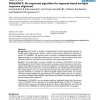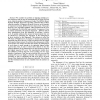820 search results - page 13 / 164 » Using Multiple Alignments to Improve Gene Prediction |
100
Voted
BMCBI
2005
14 years 11 months ago
2005
Background: Pairwise stochastic context-free grammars (Pair SCFGs) are powerful tools for evolutionary analysis of RNA, including simultaneous RNA sequence alignment and secondary...
BMCBI
2005
14 years 11 months ago
2005
Background: We present a complete re-implementation of the segment-based approach to multiple protein alignment that contains a number of improvements compared to the previous ver...
BMCBI
2006
14 years 11 months ago
2006
Background: Local structures of target mRNAs play a significant role in determining the efficacies of antisense oligonucleotides (ODNs), but some structure-based target site selec...
BIBE
2007
IEEE
15 years 6 months ago
2007
IEEE
Abstract—We consider the problem of aligning multiple protein sequences with the goal of maximizing the SP (Sum-of-Pairs) score, when the number of sequences is large. The QOMA (...
BMCBI
2006
14 years 11 months ago
2006
Background: Quantitative simultaneous monitoring of the expression levels of thousands of genes under various experimental conditions is now possible using microarray experiments....



